Despite a run of cool and cloudy weather, and a few sprinkles on Saturday, we did manage to inspect both hives Sunday afternoon, and the difference in progress between the hives is notable.
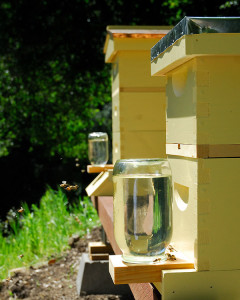
We currently have two hives, one housing a primary swarm (rear), and one housing the afterswarm from the same parent colony (front)
The Primary Swarm Inspection
The first colony of bees we hived at the end of March arrived with a mated Queen, and was housed with some previously drawn comb. The presence of capped brood on the 9th day after arrival suggested that the Queen resumed her egg-laying duties almost immediately.
This last week, around April 20th, the first of the new worker bees should have been emerging from their cells. The first generation of bees to hatch in our apiary.
The purpose of this inspection was to see if there was any noticable change in colony size. We also needed to know if the production of burr comb had ceased, or if that needed to be addressed further.
We removed the lid on the Salvia hive, and noticed a very small blob of burr comb visible through the inner cover. As the inner cover has a hole, and bees like to fill holes with comb, this isn’t an unexpected finding.
Fortunately, this was the only burr comb noted in the entire hive. A drastic improvement from our last inspection!
As we removed the inner cover, we were immediately greeted with a view of our first varroa mite of this inspection.
As it’s an entire post in itself, we’ll discuss varroa mites more at a later date, but these disease carrying, hemolymph sucking parasites aren’t a bee’s best friend. That said, they are now ubiquitous in hives throughout the United States, and beekeepers who profess not to have them, likely aren’t looking close enough. We haven’t seen very many mites so far, but it’s still early in the season, and I’m sure we’ll see a lot more in the coming months.
For those of us with seasonal allergies we’ve been well aware that the pollen counts have been very high here in recent weeks…a…a…achooooo!!! Passive observations in the week leading up this inspection also suggested high pollen counts, as it seemed that every few bees arriving at the hive entrance was heavily laden with pollen.
The very first frame we pulled in the upper hive body confirmed there is absolutely no shortage of pollen in this hive!

This colorful pollen-packed frame wasn't a surprise finding after watching the volume of pollen being carried in through the hive entrance the past week
New with this inspection however was the presence of brood in the upper hive body.
Lots, and lots, and lots of brood!
Her Royal Highness has been very busy since our last inspection 13 days ago! At that time we only found nectar and pollen in these frames.
We also noted a significant amount of capped drone brood throughout the hive. Drone brood cells (housing male bees) are distinctive because the cappings over worker brood (female bees) tend to be more flush with the edge of the comb, but drones are significantly larger bees, and as such the caps over their brood cells are more dome-shaped.
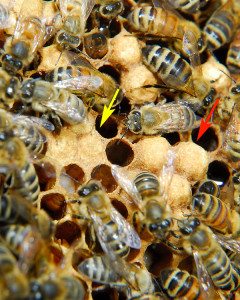
The caps over worker brood (yellow arrow) tend to be flat, whereas the caps over drone brood (red arrow) are dome-shaped
This makes it very easy to spot drone brood on the frames.
We’re not going to read too much into this amount of drone brood at the moment, as there was also plenty of worker brood present. It’s spring swarm/drone-rearing season, and the amount of drone brood produced tends to vary from hive to hive. It may simply be that this hive produces a higher percentage of drones. We’ll have to see how future inspections of this hive look.
Most notable during this inspection, other than a tremendous increase in larva and capped brood, was the increased population of the hive. During the first two inspections we had 8 solid frames of bees. This inspection however we had 12+ frames of bees. However, as the bees from the initial swarm senesce, we expect we may soon see a brief dip in the population. Providing the Queen is healthy and continues laying though, she’ll soon replace any bees lost to advancing age.
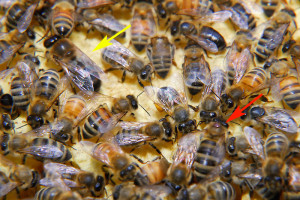
Note the drone (yellow arrow) is a larger bee, with very large eyes compared to the surrounding workers. Also note the second varroa mite seen in this inspection (red arrow)
Scanning through the sections of capped brood, we also noted a few ‘heater bees’. Heater bees climb into empty cells and by agitating their muscles can transmit heat to surrounding developing pupae, and regulate the temperature in the brood nest. [1]

Some cells are left empty amidst the brood so that heater bees (bottom up in the center) can help to regulate the temperature of developing pupae
Although there is still some remaining space in the comb in these two hive bodies, mostly toward the outer frames, we chose to add a third hive body during this inspection to give the bees time to draw comb, so they can continue to expand their brood and food reserves. We plan to leave this colony alone for the next couple of weeks before inspecting the hive again, although that somewhat depends on what’s going on in the afterswarm hive.
The Afterswarm Inspection
We captured the afterswarm from the same parent colony of bees exactly 16 days after the primary swarm above. As expected the afterswarm was comprised of a much smaller population of bees. What we weren’t sure about was whether or not we had a mated or virgin Queen in the afterswarm colony. We suspected a virgin Queen, as this colony has been casting multiple swarms this season, some in close succession.
The purpose of the afterswarm inspection was to get a realistic idea of the size of the colony. The bees were still clustered when they were transferred to the Nuc hive, and it was difficult to approximate how many frames of bees were present. It had been 9 days since this swarm was hived, and we were interested to see if there was any evidence of egg-laying, and to compare this colony with where the primary swarm had been at 9 days.
When we removed the cover we were somewhat surprised at how many bees seemed to be in residence. We’d estimated this to be a very small swarm, maybe two frames of bees, but were pleasantly surprised to find closer to four frames of bees instead.
When we first boxed this swarm we had no frames of drawn comb left, as they were in the primary swarm hive. Instead, we took a frame with new foundation and attached some of the flat burr comb that we’d removed from the primary hive during the last inspection. We simply used a pair of rubber bands to hold the comb in place. When we transferred the bees to the Nuc hive the next morning, we’d already decided it would be best to remove it, but the bees were clustered on that frame, and neither of us had scissors handy to cut the bands, so we left it. You get one guess as to what the bees did with it.
You guessed it. Burr comb.
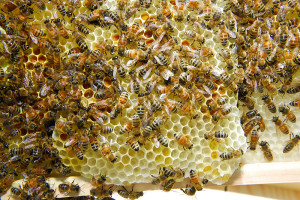
The bees took the piece of comb, drew foundation underneath it, and happily attached the burr comb to the frame
They obviously didn’t approve of the rubber bands, and discarded them.
Another lesson in beekeeping. Leave the hive decorating to the bees!
The rest of the frames however were beautifully drawn out, all the way across the hive body. We were surprised they’d drawn so much comb already.
The burr comb only had some nectar and pollen present, and was very easily removed.
The comb underneath was almost perfect, as was the comb on all of the other frames.
We went through each of the five frames of comb, and again failed to find the Queen. What we also failed to find was any evidence of egg laying. However, there were more bees than we expected, and plenty of nectar, along with some pollen, stored in the frames. We also found more varroa mites.
At the end of this inspection we added a second 5-frame medium Nuc body to this hive to give these bees more room. They’ll remain in the Nuc at least until we can determine if we have a mated Queen.
Comparing both hives at the 9 day inspection point the primary swarm already had capped brood. In this hive we couldn’t find eggs or larva, and the only thing being capped was nectar.
As such, we’re now convinced this swarm contained a virgin Queen.
It’s not yet clear whether or not she has been able to take her mating flight, and the last few days have been less than desirable weather. It’s believed that Queens need to mate within 30 days of hatching, or may not be able to mate at all. [2] It typically takes a few days for egg-laying to begin after the mating flight is completed, so it may still be some time before we know for certain if she’s been successfully bred.
We’ll re-inspect this hive in a week to look for eggs or larva. This colony otherwise seems to be normal. Drawing comb, and hoarding resources. We’ve read some reports from other beekeepers that it’s sometimes taken 20-25 days to find evidence of egg-laying from swarms with a virgin Queen, so we won’t panic, at least not yet. However, if this colony is still not looking Queen-right by the next inspection, we may consider transferring a frame with some eggs from the thriving primary swarm hive, and see if these bees will elect to raise a new Queen.
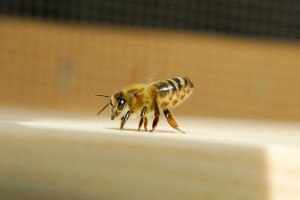
A signaling bee: some worker bees will raise their abdomens to expose their Nasonov glands, releasing Nasanov pheromone to orient workers returning from foraging missions
So, for now, the suspense in the afterswarm hive continues.
————————
[1] Tautz, Jurgen and Heilmann, Helga. 2008. The Buzz About Bees: Biology of a Superorganism. p 214-217.
[2] Root, Amos Ives. 2006. The ABC & XYZ of Bee Culture. 41st Ed. p 517.

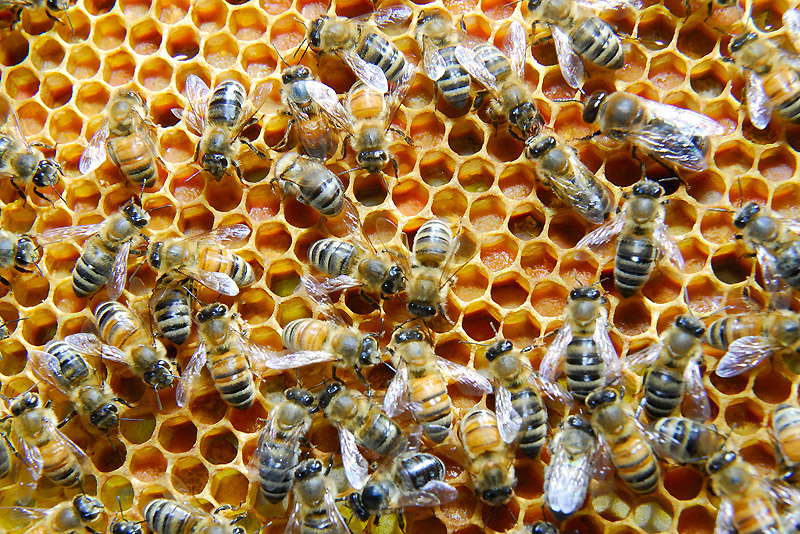

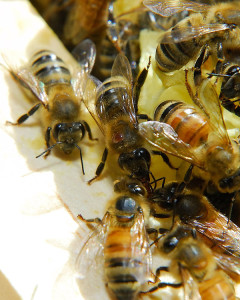
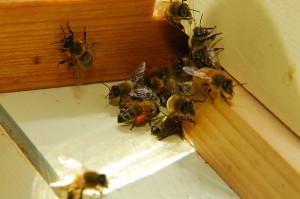
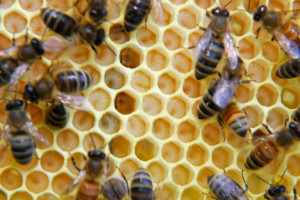



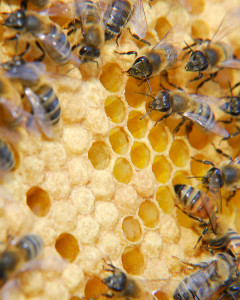



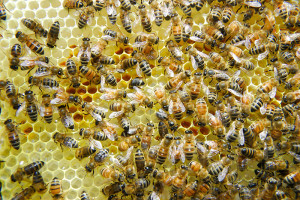
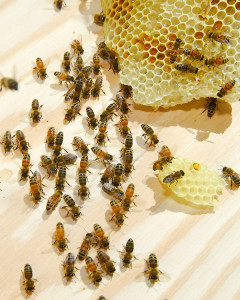
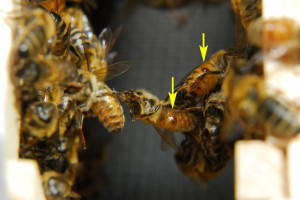
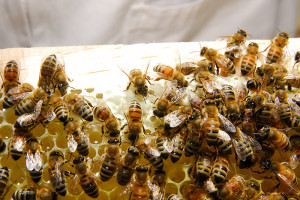








I’m so glad you’re posting all this info! We just picked up our first package of bees on Saturday. Our beekeeping book said to leave the queen in her cage corked for 5 days to ensure she’s properly accepted by the workers before removing the cork so they can eat through the candy. It’s day 3. I feel so impatient!
I suppose it depends on the style of Queen cage. Most I’ve seen, you remove the cork so they can get to the candy, and they’ll chew through in 3-5 days. I know some have multiple corks, some don’t use candy etc. I wouldn’t wait 5 days to remove the cork, and then another 3-5 for them to chew through the candy though. I’d say by 5 days total, if she’s not out, let her out, providing the workers don’t seem to be balling her. One issue that’s been mentioned at our meetings too, is to ensure the exit hole is pointing UP. If it’s facing down, and one or more attendants in the cage with her die, they can block the exit, and prevent the Queen from getting out. Good luck, and YAY you have bees!!! Looking forward to your first bee update! 😀
Great post!
I had to look this up…senesce
–verb
grow old or older; “She aged gracefully”; “we age every day–what a depressing thought!”; “Young men senesce”
Off topic: I find it especially unfortunate that “Young men senesce” lol!
LOL, unfortunately we all senesce 😉
Hi CV,
Amazing photos, it’s just so interesting watching things going on. Your knowledge of the Bees is also amazing, such wonderful little creatures.
My garden would be a terrible place without the Bees in it, and this year I have a load of mining Bees buzzing around compared to last year… I like to think I must be doing something right at least!
Mining bees are fun to watch. I agree, a garden without bees would be a very sad place to bee. 🙂
I cannot get over the pics and the incredible info …if anyone is thinking about taking up bee keeping I will point them to your blog…and I continue to see lots of honey bees visiting my bulbs in the garden…someone has a hive nearby but as yet I have not found out who
It’s also possible that the bees have a feral colony near you too, perhaps in an old tree. Regardless, it’s always good to see them in the garden. We saw a few before the hives were set up, but now they’re literally everywhere!
Wow!, You must say “Wow” a lot when doing these inspections, to bee seeing for the first time all these happenings in your own turf.
The pollen counts may bee high, but your bee colony have got to be decreasing the amount in the air in your area and doing something useful with it at least.
I say WOW constantly when I open a hive. I think I even gasped at the pollen filled frame! They get more done in a day, than I do in a whole month 😉 I’m always impressed at how very different the hive looks each time. I think I know what to expect, and I always find so much more than I anticipated. They are truly amazing creatures!
Thanks for the updates on beekeeping. Fascinating posts. I can’t wait to find out more!
How in the heck did you learn all of this stuff???! You are making me a smarter person here, this is very cool.
LOL, my television is sorely neglected, and thankfully we both love to read…a LOT! We’ve also learned a tremendous amount from other beekeepers through our local beekeeping guilds. There are some fabulous books about bee behavior and social structure, and there have been some brilliant experiments done over the years that help us understand bees better. That said though, we only know bees to a point, and there’s still much we don’t know about them. The both of us also still have so much more learn about these fabulous insects. We’re having a blast! 🙂
This information is *amazing*. I never expected to be learning about “heater bees” here, but I’m sure glad I am. Thanks, and looking forward to future bee posts!
Hi Clare, WOW, this is SO fascinating! I’m glad I took the time to read it. Such a miracle of nature. The bees sure know what they are doing. So glad you are able to capture it all and share it with those of us who would not otherwise have a clue!
Beyond impressive… and doubtless one of the most in-depth, informative blog posts I’ve read. Even footnotes: A wonder! As is your expertise.
The photos are remarkable – I’m thinking that the last one deserves to be blown-up, framed and given a place of honor! Looking like a rather sexy dance move…
Thanks Alice 🙂 I rather like that last photo myself!
Very interesting post! We’re planning on getting a hive next spring and I know I’ll be referring back to your site as a manual! Thanks for all the info and great photos!
This was an incredibly fascinating post. “Heater bees”, that was a new one for me to learn. The photos are really good too. They are very descriptive in themselves. I am enjoying your new hobby. I would love to tend bees, but being allergic, not such a good idea, so I can virtually watch your bee progress from clear across the country.
I only recently learned about heater bees myself. It is remarkable how bees, individually and collectively, work to maintain optimum temperature in the hive.
I’m in awe of your photos and depth of your knowledge about keeping bees. I will continue to watch your posts to prepare for the day when I add honey bees to my backyard.
What an amazing amount of information here – and your photos are incredible! Thanks so much for passing on your knowledge. Your posts are always so interesting.
Woot!! Another bee colony post!!! I find the comb production FASCINATING!!!!!
Absolutely fascinated by everything I’m learning here. I’m amazed you’re able to spot the different kinds of bees and mites. There’s so much action going on in these pictures you want to look at everything all at once.
Heater bees are new to me but what about drone bees Clare what is their purpose in the hive?
I’ve never seen a mite before though have heard all about them. You certainly would need to have good eyesight to see it. In the first photo I really didn’t know at first what I looking for with the red arrow as I thought it was an actual mite in the hive but I certainly saw the mites in the 2nd photo protruding from the bees body.
Drone bees aren’t good for much. We usually joke that they commandeer the remote control, wipe out the contents of the refrigerator, and expect to waited on hand and foot 😉 Actually, the honest answer is that drones, in spring, are important only for mating with the new Queens that hatch. Never within the hive though. Drones tend to accumulate in drone congregation areas, many together, from various hives, where they hope to spy a Queen on her mating flight. Each Queen will mate with up to a dozen or so drones on her mating flight (which is fatal for the drone), ideally not a drone she’s related to. Drones don’t forage for food, and they don’t care for young, so they have no other purpose. As drones are large and can consume a lot of food, they typically are evicted from the hives in the autumn when the bees are building up the last of their winter reserves. The guard bees will actually prevent the drones from re-entering the hives to protect their food stores.
Interesting stuff! i find it fascinating that the heater bees agitate their muscles to produce heat for the colony. Just like we rub our hands together to warm them up. I wonder if the bees take turns doing this. It seems that a bee would exhaust itself quickly doing this.
Deb, it’s my understanding that a heater bee can only engage in this activity for approximately 30 minutes at a time. There are “filler bees” that bring honey to the heater bees so they can refuel without having to travel through the hive. Also, some empty cells in the brood nest contain pools of nectar for a quick pick me up. There’s apparently no specific age class of bee that has this role in the hive. Both young and old bees can be recruited as heater bees, so I’d presume they ‘take turns’, but I’m not certain.
Thank you for such an informative post. I really needed that. I notice that you have sugar water out for the bees. Do you still need that even if there is enough pollen and nectar out and about?
Even though there is nectar and pollen about, we’re supplementing initially with the sugar syrup while they draw comb. You don’t have to feed at this stage, but most beekeepers we spoke with felt it helped during the comb building stage as it’s so energetically expensive for the bees to do that. My neighbor that caught the 3rd swarm from this hive had an entire hive body of drawn comb and honey, so he’s not feeding obviously. We’re actually going to stop feeding the large swarm hive this week, as they’ve now considerably dropped consumption, and drawn comb through most of two brood boxes. The Nuc colony though is still consuming close to a quart a day though. We only had two frames of drawn comb available for the large swarm to start with, and none for the afterswarm. I expect the Nuc bees will drop their consumption within the next 7-10 days as they finish drawing out their new frames.
What a treat you provided us! This was fascinating reading, and the detailed photos added lots. Thanks for all your hard work in preparing this post…very nice!
Fascinating read. I am not sure I followed all of it but it seems that you have a successful hive. Do you do anything to the bees with the mites?
Hi Clare, thanks for so much useful info once again! Those photos of the varroa mite were very useful (I’m always amazed at your photographic skills!) as while we don’t have them here in Australia yet, I have read that it is only a matter of time as they are already in New Zealand.
It was very interesting to read about the afterswarm hive…I’ll be reading on to see what happens next!
Looking good!!!!
We did not observe the Great Drone Kick-Out in the fall. But then, our bees flew all winter long. We did not notice winter drones, so perhaps we missed Eviction Day.
Do you own ABC/XYZ? Fancy!!!
I’ll be curious to see if we notice a mass drone eviction this fall. We do own ABC & XYZ. It’s an interesting encyclopedia of beekeeping, but not my favorite book if I’m honest. More a curiosity than a particularly useful reference. I’m still on the hunt for that one great bee book. Maybe someday I’ll find it 😉
I think you just saved us a lot if money! Thank you!